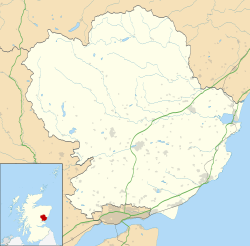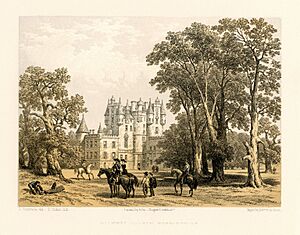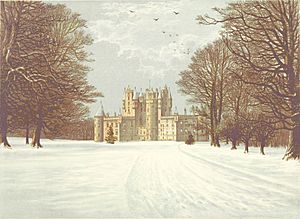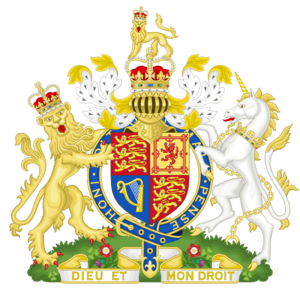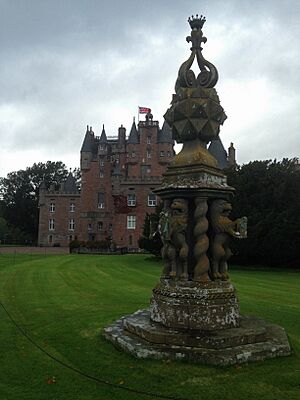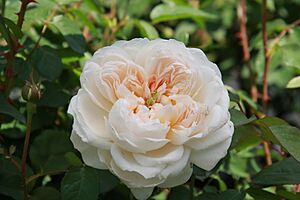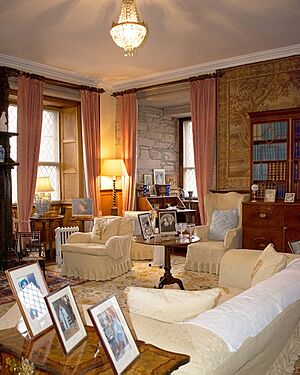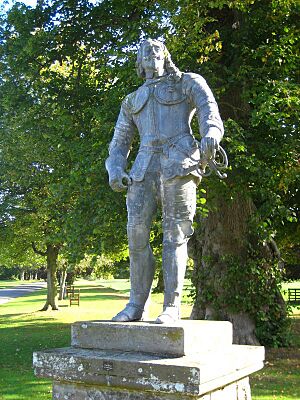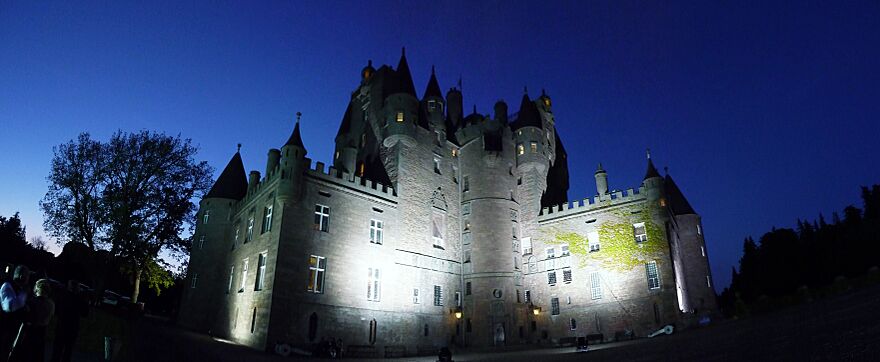Glamis Castle facts for kids
Quick facts for kids Glamis Castle |
|
|---|---|
| Near Glamis, Angus, Scotland, United Kingdom | |
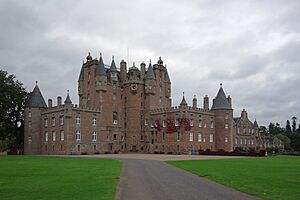
Glamis Castle
|
|
| Coordinates | 56°37′13″N 3°00′09″W / 56.6203°N 3.0024°W |
| Site information | |
| Open to the public |
Yes |
| Condition | Preserved |
| Site history | |
| Materials | Stone |
Glamis Castle is a famous castle located near the village of Glamis in Angus, Scotland. It is the family home of the Earl of Strathmore and Kinghorne. Today, you can visit the castle and explore its history.
The Lyon family has lived at Glamis Castle since the 1300s. However, most of the building you see today was built in the 1600s. Glamis Castle was also the childhood home of the late Queen Elizabeth, The Queen Mother. Her second daughter, Princess Margaret, was born there on August 21, 1930.
The castle is a very important historical building, protected as a category A listed building. Its beautiful gardens are also recognized as important national gardens in Scotland.
Contents
Where is Glamis Castle?
Glamis Castle is located in a wide, fertile valley called Strathmore. This area is in Forfar, the main town of Angus. It sits between the Sidlaw Hills to the south and the Grampian Mountains to the north. The castle is about 20 kilometers (12 miles) from the North Sea.
The land around the castle is huge, covering more than 57 square kilometers (14,000 acres). Besides its parks and gardens, the estate grows crops like lumber and raises beef. Two streams flow through the estate, including the Glamis Burn. There is also a special garden called an arboretum overlooking Glamis Burn. It has trees from all over the world, some of them very old and rare.
A Look at Glamis Castle's History
The area around Glamis Castle has signs of people living there long ago. For example, a special carved stone from the ancient Pictish people, called the Eassie Stone, was found nearby.
In 1034, King Malcolm II was killed at Glamis. At that time, there was a Royal Hunting Lodge on the site of the castle. Later, in William Shakespeare's play Macbeth, the main character lives at Glamis Castle. However, the real King Macbeth (who died in 1057) had no connection to the castle.
How the Lyon Family Got the Castle
By 1372, a castle had been built at Glamis. That year, King Robert II gave it to Sir John Lyon. Sir John was the Thane of Glamis and married to the king's daughter. The Lyon family (later called Bowes-Lyon) has owned Glamis Castle ever since. The castle was rebuilt in the early 1400s as an L-shaped tower house.
The title Lord Glamis was created in 1445 for Sir Patrick Lyon. He was Sir John's grandson.
Lady Janet Douglas
John Lyon, 6th Lord Glamis, married Janet Douglas. This was during a time when King James V was having problems with the Douglas family. In 1528, Janet was accused of treason. She was also charged with poisoning her husband, Lord Glamis, who had died that year. Sadly, she was later accused of witchcraft and was executed in Edinburgh in 1537. King James V then took control of Glamis Castle and lived there for a while.
In 1543, Glamis Castle was given back to John Lyon, 7th Lord Glamis.
Changes and Renovations
In 1606, Patrick Lyon, 9th Lord Glamis, became the Earl of Kinghorne. He started big building projects on the castle. An inscription on the central tower remembers this work. It says, "Built by Patrick, Lord Glamis, and D[ame] Anna Murray." Some people thought the English architect Inigo Jones designed the changes. But Historic Scotland believes William Schaw, the King's Master Mason, is more likely. This is because the castle's style is very Scottish.
During the time of the Commonwealth of England, Scotland, and Ireland, soldiers stayed at Glamis. In 1670, Patrick Lyon, 3rd Earl of Strathmore and Kinghorne, returned to the castle. He found it in bad shape. Restorations happened until 1689. This included creating a large Baroque garden.
John Lyon, 9th Earl of Strathmore and Kinghorne, became Earl in 1753. In 1767, he married Mary Eleanor Bowes, who inherited a lot of money from coal mines. He used this money to improve the castle grounds in the 1770s. The south-west part of the castle was rebuilt after a fire in the early 1800s. Many rooms, like the Dining Room, also date from the 1700s and 1800s.
Royal Connections
In 1900, Lady Elizabeth Bowes-Lyon was born. She was the youngest daughter of Claude Bowes-Lyon, 14th Earl of Strathmore and Kinghorne. She spent much of her childhood at Glamis. During the First World War, the castle was used as a military hospital. Lady Elizabeth helped save the castle's contents during a serious fire in 1916.
On April 26, 1923, she married Prince Albert, Duke of York. He was the second son of George V. Their second daughter, Princess Margaret, was born at Glamis Castle in 1930.
Since 1987, a picture of Glamis Castle has been on the back of ten pound notes from the Royal Bank of Scotland. Today, Glamis is the home of Simon Bowes-Lyon, 19th Earl of Strathmore and Kinghorne. He became Earl in 2016.
Statues at Glamis Castle
In the 1600s, four large statues were placed on the path leading to the castle. These included statues of King Charles I, King James VI, King Charles II, and King James VII. The first two were made by a sculptor named Arnold Quellin.
Legends and Spooky Tales
Glamis Castle is famous for its many legends and ghost stories.
The Monster of Glamis
One of the most famous legends is about the Monster of Glamis. This story says a child born into the family was terribly deformed. Some stories say this monster was kept hidden in the castle his whole life. After he died, his rooms were supposedly bricked up. Another version says a vampire child is born to the family every generation and is walled up in a room.
An old tale says that guests once hung towels from every window of the castle. They wanted to find the bricked-up rooms of the monster. When they looked from outside, several windows had no towels. This might have been because the owners removed them so the guests wouldn't find the secret rooms. The legend of the monster might have come from a true story about another family, the Ogilvies.
Earl Beardie's Card Game
Another legend tells of "Earl Beardie" from the 1400s. There are different versions of this story, but they all involve Earl Beardie playing cards. It was the Sabbath, a holy day, and he was told to stop playing. But Earl Beardie became very angry. He declared he would play until doomsday, or even with the Devil himself!
Then, a stranger appeared at the castle and joined Earl Beardie's card game. This stranger was believed to be the Devil. The Devil took Earl Beardie's soul. In some versions, the Earl is condemned to play cards forever.
Other Castle Traditions
According to the official Glamis Castle website, King Malcolm II was badly hurt in a battle nearby in 1034. He was taken to a Royal Hunting Lodge, which was on the site of the current castle, and he died there.
Inside Glamis Castle
The towers at the front of the castle are about 7 meters (23 feet) wide and 4 meters (13 feet) high. They have modern tops. The walls of the castle are 1 meter (3 feet) thick.
There is a small chapel inside the castle that can seat 46 people. Castle tour guides tell visitors that one seat in the chapel is always saved for the "White Lady." This is supposedly a ghost that lives in the castle. Many believe she is Janet Douglas, Lady Glamis. The guides say the chapel is still used for family events, but no one is allowed to sit in that special seat.
Castle Archives
The clock tower at Glamis Castle holds the castle's archives. These are like a huge collection of historical documents. They include many materials about the castle and the Bowes and Lyon families. You can find a papal bull (a special document from the Pope) and the memories of Mary Eleanor Bowes there. The Glamis archives work closely with the archives at the University of Dundee. Researchers who want to see these materials can do so at the university.
See also
 In Spanish: Castillo de Glamis para niños
In Spanish: Castillo de Glamis para niños


